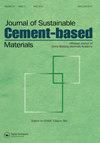One-phase improvement of sandy soil using seawater-based soybean-induced carbonate precipitation
IF 4.2
3区 工程技术
Q1 CONSTRUCTION & BUILDING TECHNOLOGY
Journal of Sustainable Cement-Based Materials
Pub Date : 2022-11-11
DOI:10.1080/21650373.2022.2142985
引用次数: 7
Abstract
Seawater-based soybean-induced carbonate precipitation (SSICP) was proposed for sandy soil improvement. A series of comparative bio-cementation tests on Ottawa sand and sea sand through SSICP and deionized water-based soybean-induced carbonate precipitation (SICP) were carried out. Experimental results indicate that seawater can be used to extract soybean urease. It has a certain negative effect on urease activity, but SSICP method has better sand improvement performance. When the soybean powder concentration is 100 g/L and soaking time is 60 min, related urease activity exceeds 2.50 U. It increases as the soaking time increases before 60 min, and then decreases. Generally, urease activity of deionized water-extracted soybean urease is higher than that extracted by seawater. The compressive strength of SSICP bio-cemented Ottawa sand blocks reaches 401.67 kPa, which is about twice of that bio-cemented by SICP (191.62 kPa). The better sand improvement mechanism of the SSICP method can be attributed to the mixture of calcium carbonate and calcite magnesium produced by the SSICP process is beneficial to improve sand strength compared to calcite only produced by the SICP process. The performance of carbonate precipitation and bio-cementation on Ottawa sand is better than those on sea sand, resulting in lower compressive strength and carbonate content of sea sand blocks.海水大豆诱导碳酸盐沉淀一期改良沙质土壤
采用海水大豆诱导碳酸盐沉淀法(SSICP)改良沙质土壤。通过SSICP和去离子水性大豆诱导碳酸盐沉淀(SICP)对渥太华砂和海砂进行了一系列生物胶结对比试验。实验结果表明,海水可用于大豆脲酶的提取。对脲酶活性有一定的负面影响,但SSICP法具有较好的改沙性能。当大豆粉浓度为100 g/L,浸泡时间为60 min,相关脲酶活性超过2.50 U.在60之前,它随着浸泡时间的增加而增加 min,然后减小。一般来说,去离子水提取的大豆脲酶活性高于海水提取的脲酶活性。SSICP生物胶结渥太华砂块抗压强度达401.67 kPa,大约是SICP生物胶结的两倍(191.62 kPa)。SSICP法较好的改砂机理可归因于SSICP法生产的碳酸钙和方解石-镁的混合物与仅SICP法生产的方解石相比,有利于提高砂的强度。渥太华砂的碳酸盐沉淀和生物胶结性能优于海砂,导致海砂块的抗压强度和碳酸盐含量较低。
本文章由计算机程序翻译,如有差异,请以英文原文为准。
求助全文
约1分钟内获得全文
求助全文
来源期刊
CiteScore
6.60
自引率
15.90%
发文量
71
期刊介绍:
The Journal of Sustainable Cement-Based Materials aims to publish theoretical and applied researches on materials, products and structures that incorporate cement. The journal is a forum for discussion of research on manufacture, hydration and performance of cement-based materials; novel experimental techniques; the latest analytical and modelling methods; the examination and the diagnosis of real cement and concrete structures; and the potential for improved cement-based materials. The journal welcomes original research papers, major reviews, rapid communications and selected conference papers. The Journal of Sustainable Cement-Based Materials covers a wide range of topics within its subject category, including but are not limited to: • raw materials and manufacture of cement • mixing, rheology and hydration • admixtures • structural characteristics and performance of cement-based materials • characterisation techniques and modeling • use of fibre in cement based-materials • degradation and repair of cement-based materials • novel testing techniques and applications • waste management

 求助内容:
求助内容: 应助结果提醒方式:
应助结果提醒方式:


